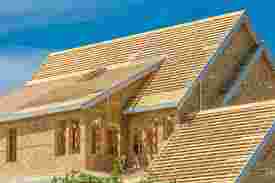Choosing the right roofing material is a crucial decision for any UK property owner. The roof not only protects your home from the unpredictable British weather, but it also plays a major role in insulation, aesthetics, and long-term property value. With so many options available, knowing the pros and cons of each material can help you make the best choice for your location, budget, and home style.
Whether you’re planning a full roof replacement or a new build, understanding the top roofing materials in the UK will help you avoid costly mistakes and ensure long-term performance.
1. Slate Roofing
Overview
Slate is one of the oldest and most traditional roofing materials used in the UK. Its natural appearance, durability, and long life make it a premium choice, especially for period properties and heritage homes.
Advantages
-
Extremely long lifespan (up to 100 years or more)
-
Fire-resistant and environmentally friendly
-
Adds a high-end look to your property
Considerations
-
Higher cost compared to other materials
-
Requires a skilled installer due to its weight and fragility
-
May need reinforced roof structure
Slate is ideal for homeowners looking for durability and aesthetic appeal, particularly in areas with conservation requirements.
2. Clay Tiles
Overview
Another traditional favourite, clay tiles are commonly seen on homes across the South of England. They offer excellent weather resistance and come in a variety of styles and colours.
Advantages
-
Long lifespan (up to 60 years)
-
Resistant to rot, insects, and harsh weather
-
Beautiful appearance that suits older and modern homes alike
Considerations
-
Can be brittle and may break under impact
-
Heavy—similar to slate, the structure must support the weight
Clay tiles are particularly well-suited for cottages, townhouses, and properties in rural or coastal settings.
3. Concrete Tiles
Overview
Concrete tiles have become a popular choice in modern construction due to their affordability and availability. They can mimic the appearance of slate or clay but at a lower cost.
Advantages
-
Cost-effective and widely available
-
Versatile in terms of style and colour
-
Durable with a lifespan of 40–50 years
Considerations
-
Heavier than some alternatives
-
Can fade over time
-
Not as long-lasting as slate or clay
Concrete tiles are often chosen for new-build properties or refurbishments where budget is a key concern.
4. Asphalt Shingles
Overview
Although more common in North America, asphalt shingles are gaining traction in the UK as a low-cost roofing option, particularly for garages, sheds, and extensions.
Advantages
-
Very affordable
-
Quick to install and easy to replace
-
Lightweight
Considerations
-
Shorter lifespan (around 20 years)
-
Not as suitable for traditional UK architectural styles
-
More prone to damage in high winds
Best used for smaller buildings or temporary solutions, not typically recommended for full-scale residential homes.
5. Metal Roofing
Overview
Metal roofing, including steel and aluminium, is becoming increasingly popular in the UK due to its durability, eco-friendliness, and sleek modern look.
Advantages
-
Extremely durable and resistant to harsh weather
-
Lightweight and recyclable
-
Long lifespan (up to 70 years)
Considerations
-
Can be noisy during rain or hail unless insulated
-
Higher upfront cost
-
Industrial look may not suit all homes
This is a strong option for modern or minimalist home designs, especially in areas exposed to strong winds or heavy rain.
6. Green Roofs
Overview
Green roofs are living systems that incorporate vegetation, offering both insulation and environmental benefits. More common in urban areas, they’re ideal for eco-conscious homeowners.
Advantages
-
Improves insulation and energy efficiency
-
Reduces rainwater runoff
-
Enhances biodiversity and air quality
Considerations
-
Requires professional design and maintenance
-
Higher initial cost
-
Not suitable for all roof structures
Green roofs are gaining popularity in cities and areas with flat or low-pitch roofs.
7. Flat Roofing Materials
For properties with flat roofs, common in extensions, garages, and commercial buildings, the choice of material is especially important. Options include EPDM rubber, GRP fiberglass, and bitumen-based systems.
-
EPDM Rubber: Long-lasting and low-maintenance
-
GRP Fiberglass: Seamless and durable
-
Torch-On Felt: Budget-friendly but shorter lifespan
When considering flat roofing Egham, many homeowners are turning to modern materials like EPDM for their waterproofing reliability and low maintenance requirements.
Choosing the Right Roofing Material
Several factors influence the best roofing material for your property:
-
Budget: Natural materials like slate and clay are more expensive upfront but offer longer lifespans.
-
Aesthetics: Consider how the roofing material complements your property style.
-
Local Climate: Some materials fare better in coastal or high-rainfall areas.
-
Building Structure: Heavier materials require stronger support.
Consulting a professional is always advised. Whether you're dealing with a new installation or an emergency roof repair Staines, an expert assessment can help you select the right solution for your home and avoid potential issues down the line.
Final Thoughts
Your roof is one of the most important components of your home—it protects, insulates, and defines your property’s appearance. Choosing the right material not only ensures long-term performance but also increases your home’s value and energy efficiency.
If you’re unsure where to begin, contacting a local expert like a roofer Virginia Water can provide the insights and services needed to make the right choice for your specific property.




